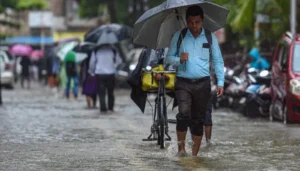Maharashtra government has initiated a pilot program to test staggered office timings and explore alternative transport solutions across the Mumbai Metropolitan Region (MMR).
The move was prompted by a tragic incident in June 2025, where five commuters died after falling from an overcrowded train between Mumbra and Diva stations.
This led to renewed urgency in addressing urban mobility challenges across the region.
Addressing Peak-Hour Congestion Through Staggered Timings
The state government has already implemented a revised schedule for its own employees, allowing them to report to work 30 minutes later than usual and extend their workday accordingly.
This adjustment is aimed at easing the morning rush on Mumbai’s local trains, which carry nearly eight million commuters daily.
The revised timings are expected to reduce peak-hour pressure between 8–11 am and 5–8 pm, when congestion is at its worst.
To expand the initiative, a 12-member task force has been formed under the leadership of the Chief Secretary.
The committee includes senior officials from departments such as transport, urban development, finance, labour, and industry, along with district collectors and representatives from employee unions.
The task force has been given three months to submit its feasibility report.
It will assess whether staggered office hours can be extended to private firms and central government offices in Mumbai and nearby districts.
Private Sector Engagement and Implementation Challenges
Central Railway has reached out to over 800 private companies to explore alternate work schedules.
These schedules include shift options such as 8 am–4 pm or 10 am–6 pm, aimed at easing peak-hour commuter traffic.
However, previous efforts to engage the private sector yielded limited participation, with only 46 firms responding positively, most of them small enterprises.
The government hopes that renewed outreach and media attention will encourage broader adoption this time.
Experts suggest that staggered timings could offer a low-cost, demand-side solution to reduce commuter density without requiring major infrastructure investments.
However, implementation may be uneven across sectors, especially in industries with rigid operational hours.
Coordinating across departments and monitoring compliance are expected to be key challenges.
Maharashtra Govt Exploring Alternative Transport Modes
Alongside staggered timings, the Maharashtra government is actively exploring new transport options to ease pressure on the rail network.
These include:
- Pod taxis (Personal Rapid Transit systems), with land already allocated in Bandra-Kurla Complex and proposed extensions to Mira-Bhayander, Thane, and Navi Mumbai
- Water transport, bike taxis, and ropeways, aimed at improving last-mile connectivity and reducing road congestion
Transport Minister Pratap Sarnaik confirmed that the state is collaborating with the Union Ministry of Road Transport to pilot pod taxis in Baroda.
If the project proves successful, the model will be replicated in Mumbai.
Maharashtra Govt Safety Measures and Infrastructure Upgrades
The government is in talks with the Railway Ministry to introduce automatic door-closing mechanisms on local trains.
This safety feature is intended to help prevent passengers from falling during transit.
Previous investments in metro lines and foot overbridges have been made to improve transit infrastructure.
However, overcrowding continues to be a serious concern, especially on the Thane–Kalyan stretch, where 741 fatalities were reported in 2024.
Between 2022 and 2025, more than 7,500 people died and 7,200 were injured while commuting on Mumbai’s suburban rail network.
The government has reiterated its commitment to improving passenger safety and reducing fatalities through coordinated efforts across departments and agencies.
Broader Implications and Urban Planning Outlook
If successful, Maharashtra’s staggered timing initiative could become a reference point for urban mobility reform.
Other congested cities like Delhi, Bengaluru, and Kolkata may adopt similar measures to manage commuter density more effectively.
Similar strategies have been implemented in Singapore, Tokyo, and New Delhi during the COVID-19 pandemic, with varying degrees of success.
Behavioral changes in commuting patterns can lead to measurable improvements in public safety and transport efficiency.
These improvements are more likely when supported by well-designed policy and infrastructure.
The state’s approach includes short-term behavioral interventions along with long-term infrastructure planning.
This marks a shift in urban mobility strategy that focuses on human-centric design and coordinated efforts across multiple agencies.
Note: We are also on WhatsApp, LinkedIn, Google News, and YouTube, to get the latest news updates. Subscribe to our Channels. WhatsApp– Click Here, Google News– Click Here, YouTube – Click Here, and LinkedIn– Click Here.



